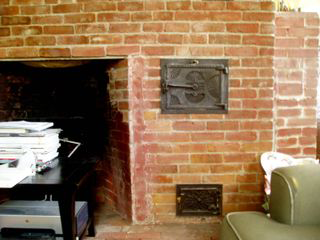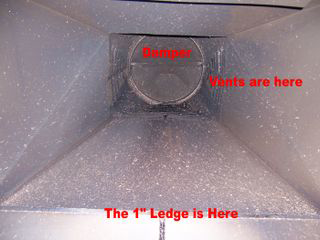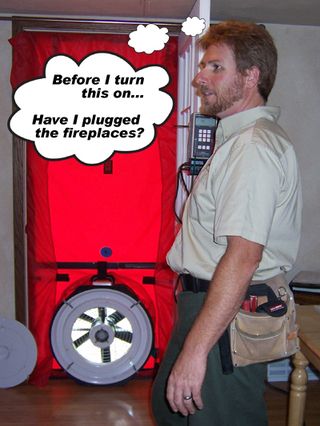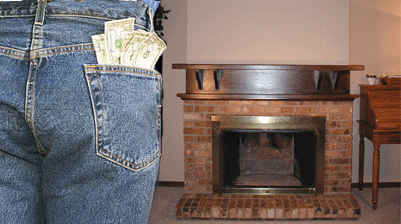
by blogediter | Mar 18, 2019 | Fireplaces
Q: Jason, One of the fireplaces in our 1844 house has an oven built into the fireplace hearth face, which we’ve never used. The oven has a door, and there is a clean-out door below the oven door. Can you make a guess if the Chimney Balloon would seal off the oven as well as the fireplace in one shot? Thanks, MB
A: Dear MB, A picture is worth a thousand words. Thank you for that photo of the hearth fireplace oven.
Sealing both with one Chimney Balloon is not recommended since you don’t know how high up the connection may be in the flue. I would sell them individually.
On the fireplace…I would measure the area where the fiberglass is at (I can see the yellow sticking down just below the lintel). I understand that is a trapezoid shape, so you will need a measurement of the front, the back, and the depth of that flue opening.
If this main fireplace flue has a fireplace damper you will also want a measurement above the damper since that may be a better location to install a Chimney Balloon if the damper hardware is in the way in the lintel area. Sealing the large flue is the main issue and that will stop most of the air infiltration, so let’s do that first.
If you still have the draft coming through the hearth oven then we can do a separate Chimney Balloon for that inlet. My suggestion for the oven would be to measure the shoot that runs out of the top or side of the oven enclosure. It should be a smallish rectangle or square vent heading up like a chimney.
With those measurements, we can get this fireplace air sealed, so the cold draft is not an issue anymore. – Jason

by blogediter | Mar 15, 2019 | Press
I was thumbing through the Department of Energy Blog and saw a great article written by Drew Bittner on Fireplaces.
I believe the article correctly called out the fireplace on its wasteful ways by saying it is an “a great big hole going to the outdoors”. Absolutely Drew! I couldn’t have said it better myself.
Just because a fireplace flue and damper is tucked out of sight doesn’t mean it does not let heat out or let cold drafts in. Also, when you go to use the fireplace you are just accelerating the rate it is exhausting your interior air. I consider it my personal crusade to let homeowners know that fireplace use does not always mean you are supplementing your homes furnace heat! In many cases, fireplace use simply wastes furnace heat and wastes the wood or gas you burn in the fireplace. – Jason

by blogediter | Mar 6, 2019 | Fireplaces
Q: Jason, I have a Heatilator Mark 123 fireplace that has a fireplace damper that is actuated by a pull chain. It is very cold in the winter and I can feel a draft come down and out of the fireplace. I see that you recommend putting the Chimney Balloon in above the damper, but the damper is about 3′ up in this application. Also, just below the damper, the walls of the flue in this area are perforated by a series of linear vent slots in an area that is about 10″ vertically. The firebox of this fireplace is trapezoid in shape (25″ length in back, 32″ length in front and 16″ from front to back) and lined with firebrick. There is a slight 1″ ledge just above the firebrick and then the metal flue immediately starts gathering upwards like an upside down funnel. My question is…where do I install the Chimney Balloon? Above the damper, below the damper, or just above the firebricks and the firebox? – FF
A: Hi FF, This Heatilator fireplace is a very common fireplace (especially in condos) and we are often asked about this particular application. We have found that it is possible to put a Chimney Balloon in any of these locations you mentioned, but installing a Chimney Balloon just above the firebox on the 1″ ledge is by far the easiest install point.
How to do the Low Install on the 1″ Ledge:
Take a 36×15 Chimney Balloon plug and unroll it out of the package so it is flat. Hold the Chimney Balloon by the valve handle in one hand and connect the inflation tube to the Chimney Balloon, and then connect the other end of that inflation tube to a Chimney Balloon pump. You will find it is easier to do this install with a pump since you will need both hands to get the Chimney Balloon into place as it inflates.
Tuck the Chimney Balloon material around all 4 edges of the ledge that is just above firebox while you hold the Chimney Balloon in place with your other hand. When you have the balloon roughly in place turn on the pump and it will start to inflate. As it inflates continue to hold the balloon in place with one hand by holding the handle valve. At the same time use your other hand to continuously work the edges of the balloon material and make sure it is staying above the ledge as you inflate. As the balloon gets tighter you will feel it start to grab and lodge itself in place.
* Note* Do not adjust the position of the Chimney Balloon while it is fully inflated. If you need to adjust its position leave the valve open and let some air escape first so the Chimney Balloon will be more pliable.
The Chimney Balloon may be slightly visible from the hearth since the install is very low, but the clear Chimney Balloon is hardly noticeable especially if you close the spark screen.
How to do the High Install just above the damper:
For a bit more of a challenge you can install a 9×9 Chimney Balloon in the flue just above the damper but you will need an Extra long 26″ HEK Extender for the handle (the 26″ is a special sized HEK extender that is not listed on the website yet, so you will need to call in your order). Attach the extra long HEK extender to the 9×9 Chimney balloon and unfold the flattened Chimney Balloon, so it is perpendicular to the long handle. Put the Chimney Balloon through the open damper so the handle sticks down through the open damper door and then inflate the Chimney Balloon into place. It is a bit tricky to get the Chimney Balloon to inflate flat in an area that is so high, so you may want to have your folding carpenters ruler handy to prod it into place if necessary. This higher install also seals well, it is just a little harder to do.
– Jason

by blogediter | Mar 4, 2019 | Save Energy
Blower Door Testing
I love going to tradeshows because it is a time that service professionals like Energy Raters and Chimney Sweeps can give us feedback on the applications that they use the Chimney Balloon in. At the 2009 ACI Conference in Kansas City, some energy auditors told us about how they use the Chimney Balloon to solve a very common fireplace soot issue during blower door testing.
Every rookie energy rater makes this mistake at least once. You go to a home to do an energy audit and just go straight to setting up the blower door kit. You look around the house and close up all the exterior doors and windows but completely neglect to look at the fireplaces. You fire up the blower door and suddenly notice a gathering grey soot cloud billowing from the living room. You know what you did wrong, you forgot to seal the fireplace. But it is too late…you already sucked a bunch of soot down the chimney and into the home. This makes the homeowner pretty ticked off and is not a good first impression.
Sometimes this even happens if you have the fireplace damper closed. Chimneys are filled with dust, and loose soot and metal dampers are notoriously leaky, so when you bring a house down to -50 pascal you can suck an enormous amount of air through the chimney and that will draw the loose soot and dust down too. It is like taking a drinking straw that has dust lined on the inside of it and briskly inhaling through it. *cough*cough*
The old school method is to take a wet towel and toss it over the ashes in the firebox, but that doesn’t do anything for the soot that comes down the chimney. Or you can take plastic and tape it around the hearth to try to seal it that way but bricks are difficult to seal against and the tape can leave a residue. Also, this takes time to cut and tape off the plastic.
The easiest thing to do is keep a couple of the common sized Chimney Balloons handy (like a 9×9, 12×12, 24×12 and 36×15) and a Chimney Balloon pump handy and quickly inflate a Chimney Balloon in the fireplace before you start the blower door. This solution is quick and easy, and it seals nice and tight so you don’t take any chances.
The energy raters I spoke with offer Chimney Balloons to their customers as an additional product in their energy rating. So when they put the Chimney Balloon in, they bring the homeowner over to show them what they are doing and explain how sealing off the flue is a benefit not only for the blower door test but also for saving energy long term as well. 99% of the time the homeowner then asks the rater to just leave the Chimney Balloon in place and bill them for it. After all, it is probably one of the least expensive and simple improvements the homeowner can make that will significantly improve the blower door test results.

by blogediter | Feb 25, 2019 | Fireplaces
Fire Place sucksanim
On a cold winter eve who of us is not tempted to go to the living room and stoke up a fire in the fireplace and read a book in front of the fire? You may be thinking “I am doing myself a favor by supplementing the furnace with additional heat”, but in fact, you are making your house colder and could be contributing significantly to pollution depending upon how you burn.
The wood burning fireplace is a losing proposition
The air action that a wood burning fireplace initiates in our home is wasteful. The moment the damper is opened heated air begins pouring out of the top of the chimney. As the fire in the hearth accelerates, the combustion process grabs already heated air from your home and burns the oxygen and combustible gasses in it. The heat that is created in this combustion quickly rises and grabs more heated inside air and tosses it up the chimney. You can restrict the amount of inside air that the fireplace has access to by installing glass doors, but this will also severely limit the amount of radiant heat that fireplace can cast forward into your living space. This radiant heat is the heat you feel on your skin in front of the fireplace and is the only usable heat that the fireplace will produce since the combustion heat is pouring out the top of the chimney. In the meantime, the home is drawing in cold outside air from other places (i.e. windows, light sockets, doors, etc) to replace the air that is escaping the home through the chimney. This is referred to as the “stack effect”.
Loosing heat even while dormant
Even while the wood fireplace is not being used, the traditional metal dampers tend to leak air since they warp and degrade rapidly in the extreme heat and corrosive soot environment. The removable and reusable Chimney Balloon fireplace chimney damper available in assorted sizes inflates into place in the flue and seals it off efficiently to stop heat loss and the cold draft.
The good, the bad, and the pollution
If you burn a fast hot fire this creates very little smoke and pollution, and it can give you a noticeable amount of radiant heat gain in the room the fireplace it is in. However, it is using volume amounts of your already heated inside air for its combustion which exceeds your heat gain ratio. A slower fire is even worse since you are still loosing heated air out the chimney and getting very little radiant heat in return. This black type of fireplace smoke is a terrible pollutant and contributes to respiratory irritant for people with asthma and allergies.
Wood burning fireplaces are wonderful nostalgic centerpieces for many American homes. But a homeowner should be aware of the issues associated with fireplace use.
Sources:
US Department of Energy
WoodHeat.org
GreenBuildingElements.com




